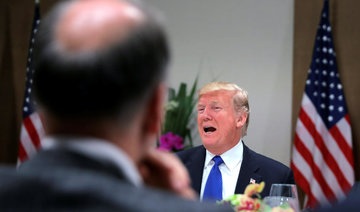WASHINGTON: Congress will hit an initial deadline Monday for resolving the fate of “Dreamers,” with nothing to show for months of negotiations over nearly two million immigrants who arrived in the US illegally as children.
When President Donald Trump last September scrapped a program that shielded large numbers of young arrivals from deportation, he gave lawmakers six months to craft a solution.
They bickered. Young immigrants and activists launched fiery protests. Trump himself relentlessly thrust himself into the thorny debate, tweeting about Democrats “blowing the one great opportunity they have” to forge a deal.
No deal ever came, leaving nearly 700,000 young immigrants who signed up for the Deferred Action for Childhood Arrivals (DACA) program in potential legal limbo, and a Congress red-faced over its monumental failure.
The court system has given a temporary reprieve. Two federal judges ruled that the Trump administration cannot immediately begin deporting DACA recipients after March 5 while courts weigh legal challenges over ending the program, and that the immigrants can begin applying for renewals under the court order.
Trump recently sought to get that order overturned by the Supreme Court, but the justices declined to intervene, meaning it could take months before appeals courts determine how officials can proceed.
While the courts give DACA recipients breathing room beyond March 5, activists and lawmakers warn that extra time is not what focuses the mind in Washington.
“When we have a deadline... we get really serious about it,” number two Senate Democrat Dick Durbin told National Public Radio. “And now we don’t have that deadline in the same way we did before the court decision.”
Members of the Congressional Hispanic Caucus wrote Homeland Security Secretary Kirstjen Nielsen seeking her assurance that agents will not target DACA recipients whose status has lapsed.
“Unfortunately, President Trump has repeatedly demonstrated that he does not truly want to solve this DACA crisis,” they wrote Thursday.
“Given this posture, it is critical that DHS ensure that DACA recipients are not deported from the only country they have known.”
Congress had every opportunity to legislate a fix, but the fate of Dreamers has proved too divisive for lawmakers to resolve.
Last month, Democrats essentially forced a brief government shutdown over the issue, demanding that the Senate’s Republican leaders set aside time to debate immigration.
They agreed, but despite one week of floor debate last month, the Senate failed to pass any of a series of proposals addressing Dreamers.
Among them was a Trump-backed plan that would provide a pathway to citizenship for 1.8 million Dreamers, in exchange for billions of dollars in border security funding and dramatic curtailment of legal immigration.
Instead, the Senate could punt. A bipartisan pair of senators introduced bare-bones legislation this week that provides a three-year DACA extension along with three years of boosted border security funding.
Conservatives in the House of Representatives have introduced their own, more hard-line legislation addressing DACA, but it has been unable to gain sufficient support within their Republican Party to pass.
Meanwhile, immigration is all but sidelined. A recent deadly school shooting has put the issue of gun control front and center on Capitol Hill, and lawmakers must thrash out a federal spending deal.
Immigration activists warn time could be running out, especially if an appeals court ends the earlier judges’ injunctions with no protections locked in place.
“This is why we need Congress to pass a clean Dream Act that will protect us without criminalizing our families,” tweeted DACA recipient Eliana Fernandez, referring to a longstanding legislative proposal that would grant permanent residency to Dreamers.
With partisanship roiling Capitol Hill, that appeared increasingly unlikely.














